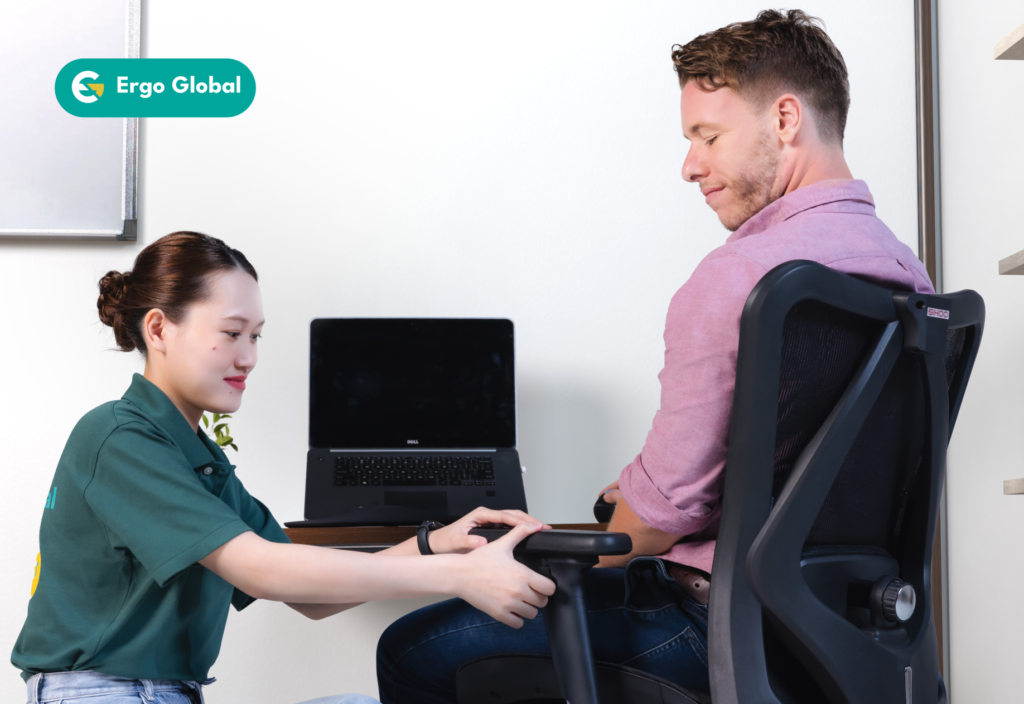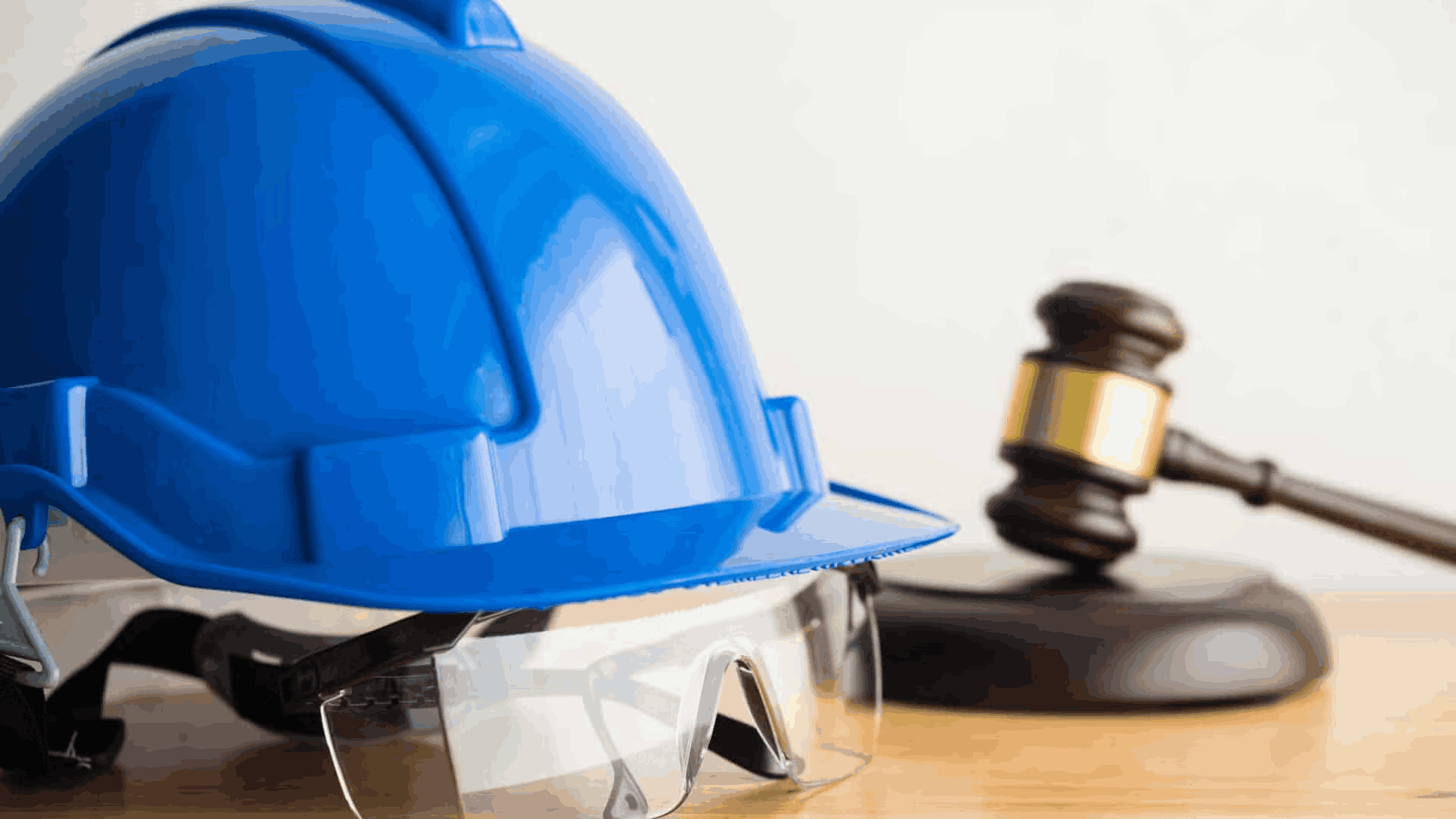Have you ever felt like your posture is causing you problems?
Do you think it’s related to how you sit or move at your workplace?
For many the answer a resounding yes.
The solution? An ergonomics assessment.
Ergonomics assessments are a detailed check of your posture, activity and routine at work. It’s designed to optimise each of these in a way that everything you do at work becomes shaped around you, rather than shaped around your work.
The Definition of an Ergonomics Assessment

So, what is an ergonomics assessment?
At the heart of it, an ergonomics assessment is the process of evaluating how well an employee’s workstation, work environment and work routine aligns with them, both in a physical and mental sense.
For example, an assessment might determine that the chair an employee is using is not set up to match that employee’s body. Perhaps the chair is too high, meaning they have to bend their neck downwards to see their monitor.
This would be considered poor ergonomics. An ergonomics assessment would find this and determine at what height the chair should be to allow the employee to view the monitor with their neck in a safe, neutral position.
In general, a thorough ergonomic assessment will check:
Workstation
- Is the chair adjusted to the employee (this includes chair height, seat pan, lumbar adjustments, armrest height, etc.)?
- Is the desk at the right height?
- Is the employee able to see the whole monitor without bending their neck downwards?
- Is the employee’s 2nd monitor in its most ergonomic position?
- Are the employee’s feet flat on the ground?
Work Environment
- Is the employee working in a noisy environment?
- Is their glare from the sun on the employee’s monitor?
- Is the employee’s workstation getting enough ambient and task lighting?
- Is the airflow in the room beneficial for the employee?
- Is the room too hot or cold for optimal focus?
Work Routine
- Does the employee take enough physical breaks?
- Does the employee take enough eye breaks?
- Does the employee experience stress from work overload?
- Does the employee have to take a lot of calls?
- Does the employee ever perform stretches?
Once the assessment has asked these questions and received answers for each, it will be able to tailor recommendations for changes that the employee can make to improve their ergonomics at work.
💡 Look out for other names for an ergonomics assessment. You might find them called ergonomics evaluations or workplace ergonomics risk assessments.
Where does an Ergonomics Assessment Happen?

Ergo assessments don’t just take place in the office (though a lot of the time, they do).
They can actually take place wherever work happens.
If you think about all the people who work in retail, hospitality, entertainment, manufacturing, etc., that’s an awful lot of employees and an awful lot of workstations to fit around them.
- Office settings like… well, you know what an office is.
- Remote settings like home offices and public transport.
- Retail settings like convenience stores and supermarkets.
- Entertainment settings like sports and theatre work.
- Industrial settings like factories, warehouses and laboratories.
Work has become a lot broader in the 21st century, and that broadening requires ergonomists to shape work around whatever it is that people do, no matter what it is.
Yes, that means even your favourite TikToker might need an ergo evaluation!
Why do an Ergonomics Assessment?
Contrary to popular opinion, ergonomics assessments are just posture fixes that may benefit how comfortable someone is feeling at work.
There’s more to it than that.
At Ergo Global, we think of assessments as employee audits that make improvements in three fields…
❣️ Health
The primary goal of ergonomics is to improve physical health by preventing employees from experiencing musculoskeletal disorders (MSDs).
An MSD is an injury to the body that affects the muscles, joints, tendons or any segment that affects physical movement.
Examples of MSDs are…
- Carpal tunnel syndrome
- Tech neck
- Lower back pain
- Tendonitis
- Eye strain
- Bursitis
Through a proper assessment of ergonomics and correction of unergonomic practices, each of these MSDs can be greatly reduced or even eradicated completely.
🪷 Wellbeing
One of the secondary goals of ergonomics is to improve the mental wellbeing of the employee while they are working.
This includes a part of the ergo assessment where the employee will be asked about the details of their job and how they could change certain parts of it to fit more around themselves as an individual human.
This could be a look into their routine to see how many breaks they take throughout the day, what they usually eat and drink to stay energised, how often they speak to colleagues about non-work-related topics.
We could look into their scheduling, which would show us how they manage their tasks, how they arrange their meetings throughout the day.
All of this is to try and build the employee a healthy routine at work that prioritises the worker over the work.
Every employee has the right to a level of autonomy in their jobs that allows them to remain stress-free and perform at a pace that is comfortable and sustainable for them.
🔨 Productivity
While it’s objectively hard to measure the impacts of ergonomics on productivity in an office setting, there is a lot to be said for the role of an ergonomics assessment on simply getting more stuff done.
- Does adding a second monitor help the employee perform their task quicker?
- Does factoring in breaks help the employee to regularly refresh and produce better work?
- Does changing the details of the employee’s task lighting help them see and perform their work better?
- Does spacing out virtual calls manage to mitigate burnout and allow the employee to do more?
The biggest impact of ergonomics on productivity actually takes place in the industrial setting.
That’s because, here, we can measure the impact of ergonomics interventions in manual handles, working with conveyor belts, dumping and loading, etc.
In 2008, Goggins et. al found in 250 industrial ergonomics case studies an average reduction of 57% in MSDs equated to an average rise of 46% in productivity.
The bottom line is that ergonomics assessments creates better workstations, which creates healthier workers who take less time off and perform their jobs better.
That’s a mega win for employers.
Who Performs Ergonomics Assessments?
If your immediate answer to this is ‘an ergonomist’, then you’re bang on the money.
But did you know that you, yourself, can perform your own ergonomics assessment?
Let’s dive into those two options briefly…
Option #1 – An Ergonomist

So you likely already know that a typical ergonomics assessment is run by a licensed ergonomist.
Ergo Global has 88 ergonomists worldwide, and we vet each one to ensure that they have these 5 key skills:
- They offer technical and consultative expertise and respond to inquiries about policies, procedures, equipment modifications, staffing, and other things pertinent to ergonomics strategies.
- They are knowledgeable of the Occupational Health and Safety (OHS) regulations, psychology, musculoskeletal risks, organisational policies, and program design and implementation.
- Their education or certification must be in ergonomics or something related to nursing and physiotherapy, like occupational kinesiology, occupational therapy, design engineering, sports science, or psychology.
- They must possess problem-solving, mathematical, reasoning, analytical thinking, verbal and written English communication, interpersonal, and computer-related skills.
- They must also be willing to exert physical effort to experience what employees do.
Get in contact with one of our professional ergonomists today!
Option #2 – Yourself

So, how can you run your own ergonomics assessment?
Several ergonomics assessment and education tools, like VelocityEHS and ErgoWOW, allow employees to run their own assessments via a 30-minute questionnaire.
This self-run questionnaire asks all of the questions that an ergonomist would ask, but with the employee proceeding at their own pace through the set.
Though may not as effective as having an ergonomist directly in front of you, ergonomics platforms like these are great for auditing entire companies in a fast and cost-efficient way.
What Happens in an Ergonomics Assessment?

Though all assessments are a little different, depending on the ergonomist and the situation of the employee, most follow the same pattern:
1. Observation
The first crucial step for an ergonomist is usually a workplace tour.
This is a quick walk around the working environment (office layout, noise levels, lightning arrangements) to see what aspects of it might be hindering health and work.
This preliminary stage is just to get a feel for the office before the individual assessments begin,
2. Identification of At-Risk Employees
In this step, the ergonomics specialist will identify and workers that are most vulnerable to risks.
This depends on a few factors related to the employee’s individual situation.
Examples of the most at-risk employees are…
- Pregnant employees or new mothers
- Neurodiverse employees
- Physically disabled employees
- Older employees
This is to see which employees need the most personalised assistance.
3. Assessments
This third step is the bulk of the ergonomist’s work.
They will go directly to each employee in term, sit down with them for about 20-30 minutes and ask them a set of questions to learn more about their personal situation and job role.
They will check everything in a typical assessment, including posture, routine and their feeling on the environment in which they work.
After writing down answers from the employee, they will offer some quick fixes.
Quick fixes are recommendations that the employee can implement immediately and start to feel the benefit, like a quick adjustment to the chair, monitor height or distance of the keyboard and mouse.
4. Recommendations
This step usually takes place after the assessment has been concluded.
The ergonomist will take the answers and create a report of detailed improvements that the employee can make to the way they work.
Thus recommendation will also include an equipment list full of specialised equipment that can help the employee feel more comfortable.
3. Assessments
In this step, the ergonomics assessor lays out detailed plans, tasks, and requirements based on their evaluation.
They will present you with an evaluation form recommending appropriate modifications needed by your employees.
5. Follow-up
Not all, but many ergo evaluations will end after the recommendations have been given…
…but the best ergonomists know that it is hard for employees to adopt new positions and habits just because a specialist has told them so.
What the employee usually needs is a 2-week period to adapt to the new changes, then a follow-up from the ergonomist to see how they’re getting on.
This way, employees can have time to adapt to their new way of work in a controlled manner, rather than being expected to jump straight into it.
💡 Please bear in mind that this breakdown is for office-based ergonomics assessments. For more info on industrial ergo assessments, see this checklist by the Ergonomics Society of Africa (ESSA).

Ergonomics assessments are, for many of the billions of office workers out there, a chance to receive specialist advice on how to most healthily perform the tasks they do day in, day out.
More and more companies are seeing the benefit of such assessments, with bosses noticing not only improved health of workers, but better performance, and indirectly, higher revenues.
Contact Ergo Global to learn how we can do the same at your company!



